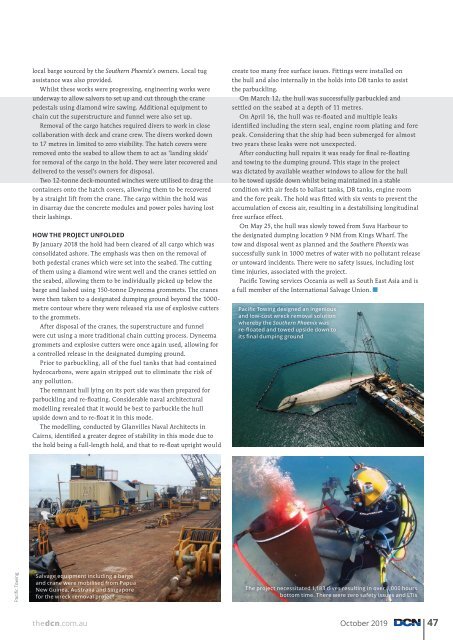DCN October Edition 2019
You also want an ePaper? Increase the reach of your titles
YUMPU automatically turns print PDFs into web optimized ePapers that Google loves.
local barge sourced by the Southern Phoenix’s owners. Local tug<br />
assistance was also provided.<br />
Whilst these works were progressing, engineering works were<br />
underway to allow salvors to set up and cut through the crane<br />
pedestals using diamond wire sawing. Additional equipment to<br />
chain cut the superstructure and funnel were also set up.<br />
Removal of the cargo hatches required divers to work in close<br />
collaboration with deck and crane crew. The divers worked down<br />
to 17 metres in limited to zero visibility. The hatch covers were<br />
removed onto the seabed to allow them to act as ‘landing skids’<br />
for removal of the cargo in the hold. They were later recovered and<br />
delivered to the vessel’s owners for disposal.<br />
Two 12-tonne deck-mounted winches were utilised to drag the<br />
containers onto the hatch covers, allowing them to be recovered<br />
by a straight lift from the crane. The cargo within the hold was<br />
in disarray due the concrete modules and power poles having lost<br />
their lashings.<br />
HOW THE PROJECT UNFOLDED<br />
By January 2018 the hold had been cleared of all cargo which was<br />
consolidated ashore. The emphasis was then on the removal of<br />
both pedestal cranes which were set into the seabed. The cutting<br />
of them using a diamond wire went well and the cranes settled on<br />
the seabed, allowing them to be individually picked up below the<br />
barge and lashed using 150-tonne Dyneema grommets. The cranes<br />
were then taken to a designated dumping ground beyond the 1000-<br />
metre contour where they were released via use of explosive cutters<br />
to the grommets.<br />
After disposal of the cranes, the superstructure and funnel<br />
were cut using a more traditional chain cutting process. Dyneema<br />
grommets and explosive cutters were once again used, allowing for<br />
a controlled release in the designated dumping ground.<br />
Prior to parbuckling, all of the fuel tanks that had contained<br />
hydrocarbons, were again stripped out to eliminate the risk of<br />
any pollution.<br />
The remnant hull lying on its port side was then prepared for<br />
parbuckling and re-floating. Considerable naval architectural<br />
modelling revealed that it would be best to parbuckle the hull<br />
upside down and to re-float it in this mode.<br />
The modelling, conducted by Glanvilles Naval Architects in<br />
Cairns, identified a greater degree of stability in this mode due to<br />
the hold being a full-length hold, and that to re-float upright would<br />
create too many free surface issues. Fittings were installed on<br />
the hull and also internally in the holds into DB tanks to assist<br />
the parbuckling.<br />
On March 12, the hull was successfully parbuckled and<br />
settled on the seabed at a depth of 11 metres.<br />
On April 16, the hull was re-floated and multiple leaks<br />
identified including the stern seal, engine room plating and fore<br />
peak. Considering that the ship had been submerged for almost<br />
two years these leaks were not unexpected.<br />
After conducting hull repairs it was ready for final re-floating<br />
and towing to the dumping ground. This stage in the project<br />
was dictated by available weather windows to allow for the hull<br />
to be towed upside down whilst being maintained in a stable<br />
condition with air feeds to ballast tanks, DB tanks, engine room<br />
and the fore peak. The hold was fitted with six vents to prevent the<br />
accumulation of excess air, resulting in a destabilising longitudinal<br />
free surface effect.<br />
On May 25, the hull was slowly towed from Suva Harbour to<br />
the designated dumping location 9 NM from Kings Wharf. The<br />
tow and disposal went as planned and the Southern Phoenix was<br />
successfully sunk in 1000 metres of water with no pollutant release<br />
or untoward incidents. There were no safety issues, including lost<br />
time injuries, associated with the project.<br />
Pacific Towing services Oceania as well as South East Asia and is<br />
a full member of the International Salvage Union.<br />
Pacific Towing designed an ingenious<br />
and low-cost wreck removal solution<br />
whereby the Southern Phoenix was<br />
re-floated and towed upside down to<br />
its final dumping ground<br />
Pacific Towing<br />
Salvage equipment including a barge<br />
and crane were mobilised from Papua<br />
New Guinea, Australia and Singapore<br />
for the wreck removal project<br />
The project necessitated 1,183 dives resulting in over 1,000 hours<br />
bottom time. There were zero safety issues and LTIs<br />
thedcn.com.au <strong>October</strong> <strong>2019</strong> 47
















